Update July 7, 2018: This post was originally published on Nov 22, 2016. Since then, I have sold the red 2012 Nissan Leaf in the picture, moved to New Zealand, and purchased a white 2013 Nissan Leaf, which I love even more! Because New Zealand is in the southern hemisphere, it is currently winter here, and my new Nissan Leaf is also a perfect winter car! Although the Auckland winter isn’t as cold as the Denver, Colorado winter, it creeps down to freezing and I love the heated seats and steering wheel.
Posted Nov 22, 2016
It is a common myth that electric cars don’t work well in the winter. Nothing could be further from the truth. In several aspects, the electric cars are actually better than conventional internal combustion cars during the winter.
Many of us start thinking about a new car during the winter. Perhaps you have discovered that your old car doesn’t want to start anymore, or you are tired of how bad it handles in the snow (provided that you live in an area that gets snow, of course). If you consider buying a new (or used) car this, you should take a close look at the electric cars. Many countries and states have generous tax credits or subsidies. However, some of these tax credits may run out at the end of the year, so if you consider buying an electric car, you might want to do so before December 31st 2016.
There are a rapidly increasing number of electric cars available on the market. As an electric vehicle enthusiast, I used to know every single model available and all their specifications, but there are now so many models that I have lost count, but luckily the Car and Driver magazine has listed them here.
This post is about winter driving, and my experience of driving a Nissan Leaf model year 2012 in Colorado, USA. My husband Bill Dube’ and I bought the car used in December 2014 and is now entering our 3rd winter season with the same car. Colorado is known for its excellent ski resorts, which means plenty of snow and cold weather. The 2014-2015 winter offered plenty of snow, putting our new car to the test. With 55 (!) inches (1.4 m) of snow and an average temperature of 36.6°F (2.5°C) in February 2015 [2], it was certainly a good test. With our electric streamliner KillaJoule occupying the entire garage, the Leaf had to be parked outdoors all winter. This was the ultimate test. We were both excited and anxious to see how it would perform. After reading about other people’s experience we were quite sure that it would just fine, and we can now conclude that it was better than expected. It has definitely become our primary car.
Before we are getting into the details, lets talk a little bit about the Nissan Leaf and its features. The Nissan Leaf is the most sold all-electric car ever. Over 200,000 cars have been sold since 2010, about half them in the U.S. [1]. It is a mid-sized car that easily seats five people, and the early models and the current entry model has a driving range per charge of about 75 miles (120 km). The 2016 SL and SV models have an upgraded battery pack (30 kWh instead of 24 kWh) and a range over 100 miles (160km). It is a peppy car and with heated leather steering wheel, heated seats (even in the back seat!) and a low center of gravity, it feels and handles like a premium car. With a starting price of $29,000 and generous federal and state incentives, you could bring home a brand new Nissan Leaf for around $20,000 if you are lucky enough to live in a country or state with generous tax credits, like Colorado. Used ones are typically about $15,000 and some of them are still eligible for tax credits. But enough about the sales numbers, this article is about winter use.
Winter tires – more important than you think!
The first challenge was to find suitable winter tires. For some reason I cannot understand, some people think you cannot have real winter tires on an electric car. I have even received the same question about our Toyota Prius. Even the mechanics at the tire store were all nervous; he had never changed tires on an electric car before. We had to ensure him that there was nothing different with this car. I will be traveling in the same mud and snow at the same speed as all the other cars. Why on Earth would I not have winter tires!? Picking winter tires for an electric car is however slightly different from a conventional car. Rolling resistance is important because high rolling resistance will immediately decrease the range. We couldn’t find any rolling resistance ratings for winter tires, but we have Hankook tires on the Prius and it had not noticeably changed the fuel economy, so we settled for Hankook Winter i-cept Evo, and they have worked great. This was 2 years ago, so I am sure there are more choices available now.
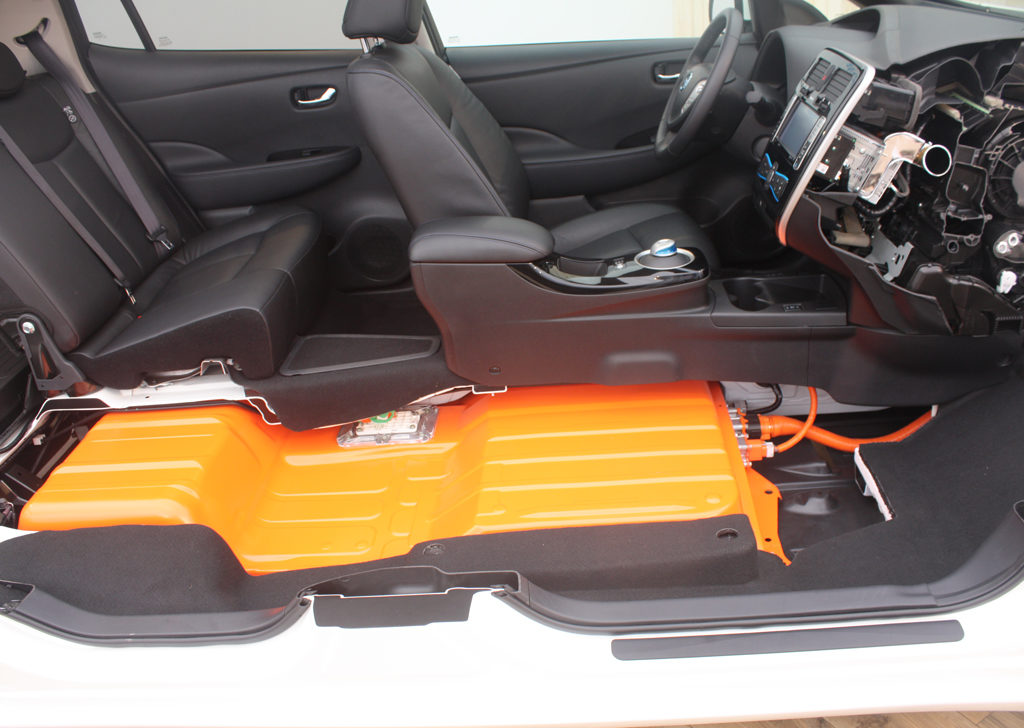
The CarWings app – the best thing since sliced bread!
Nissan has been really poor at advertising all the cool and practical features of the Leaf. When we bought our car in December 2014, we had no clue how handy the app would be. The car is connected through a 2G cell phone connection. It is built into the car and is free of charge [3]. Just download the free Carwings app to your smartphone and spend a few minutes getting your car connected and registered online (you only have to do this once, and if you buy a used car it is easy to register the new owner).
With a quick tap on your phone or tablet, (or you can use a regular computer too), you can check the charge status of the car. If it is plugged in, you will see the time to completion and the current range. If it is not plugged in, you can see the remaining range. You can also turn the climate control. If the car is plugged in, it will draw the power from the grid. This means that you can get your car warmed up (or cooled down in the summer) before you take off. Just turn it on at the same time as the coffee maker. This is more important than you may initially think. It is definitely very nice to get into a warm car a cold winter morning, but it also means that you get more range since you don’t have to use battery power to heat up a really cold car. This can give you significantly more range in the winter, which we will talk more about below.
When the car is plugged in, the climate control turns off automatically after 2 hours. It assumes that you have changed your mind, so you don’t have to be worried of forgetting the climate control on when you leave for vacation and come home to a huge electricity bill two weeks later. When the car is running on battery power, the climate control turns off automatically after 15 minutes. If you are at a restaurant, it is perfect to turn it on when the check arrives. There is no better end to a nice evening than coming out to a warm car. It is like your private valet that you never have to tip.
Note: My experience is limited to the 2012 model. The newer models may have a different app or different features, but more and more of the electric cars can be controlled through apps. Check with online resources or the dealer before you make your decision.
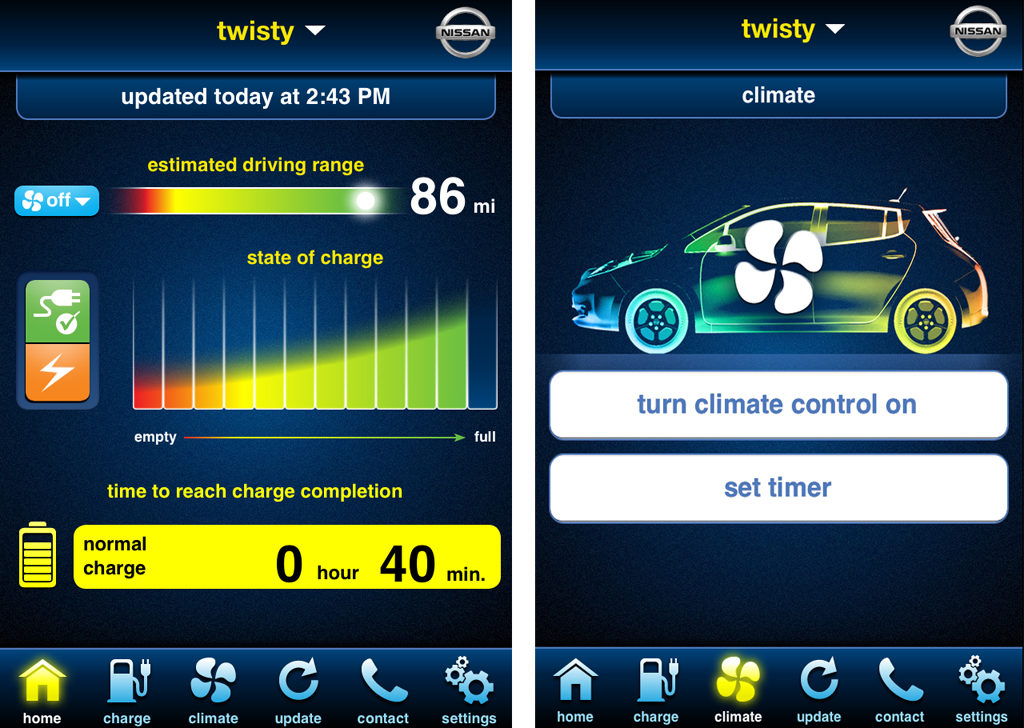
What about the range? Isn’t it drastically decreased? No, not necessary, it is kind of up to you.
If you mention “electric car” and “winter” in the same sentence, somebody will directly ask about decrease in range, so let’s talk about range.
It is well-known that batteries can lose some of their power if they get cold. This is the main reason why conventional cars can be difficult to start when it is cold: the starter battery has lost a good fraction of its power. (It hasn’t lost energy or capacity, just power. Basically in cold weather it loses much of its ability to rapidly deliver the energy it contains.) Although the battery temperature in the Leaf will go down a bit at very low ambient temperatures, this is not the main reason for the decreased winter range. The battery generates enough heat during charging and is well-insulated to stay at a sufficient temperature. It also has built-in heaters to keep it from reaching extremely low temperatures that would affect the cars performance (standard from model year 2012) [4].
The main reason for the decreased winter range is the wimpy, hairless creatures driving the car. If we could accept having freezing temperatures inside the car, the decrease in range would be marginal. We expect the same temperature in our car as in our home, and we are used to getting the heat “for free” from the internal combustion engine. But an electric motor is so efficient (over 90 %) that there is no waste heat to speak of. The heat has to be generated using power directly from the battery.
At freezing temperatures, the driver’s compartment heating system can draw as much 4.5 kW or over 6 HP. That is about the same as the traction power used to cruise at 45 mph (70 km/h). With the heating system drawing as much power as the motor, it is easy to see why the range will be drastically decreased.
The Leaf uses several tricks to keep down the energy consumption for driver’s comfort. The steering wheel is heated, and so are all the seats (including the rear seat). This gives high comfort even at a lower cabin temperature. I find myself cranking up the heat in my Toyota Prius hybrid car to max just because my hands get so cold from holding the steering wheel. The heated steering wheel really reduces this energy-wasting behavior. The heating power for the cabin is also reduced when you choose the “Eco” driving mode. Another habit-changing feature is that the car clearly tells you how much range you are losing by using the heat. The option to remotely start the heat while still plugged in is another feature that also increases the range.
All that said, how did the range change during the winter months? Well, as expected, it was indeed reduced on very cold days. Bill’s daily commute is 50 miles (25 miles one way), so this is what the car had to be able to do. Although Bill can charge during the day, he doesn’t want to rely on it. FleetCarma has collected real-life data from Leaf owners, which is shown in the graph below [6]. We studied the FleetCarma plot at length before we made the decision to purchase the car. Our experience from this winter is that our Leaf follows the “average range” very closely. If you want to have high driver’s comfort, the range will be reduced from the typical 75-80 miles to about 50 miles when the mercury creeps down to -15°F (-25°C). You can increase the range by starting the climate control while the car is still plugged in, and by trading in some of the driver’s comfort. An extra coat will give you a few extra miles.
The newer model year Leafs, 2013 and up, have a much more efficient way of heating the cabin. They offer an optional “heat pump” which consumes only about 1/3 of the energy to deliver the same amount of heat [5]. A heat pump is basically an air conditioner that works in reverse, cooling the air outside of the car and moving that heat to the interior of the car. It adds a small additional cost, but in cold climates it is a popular option.
Another positive thing with an electric car is that it will always start. There is no worry that the engine won’t start because it is too cold, because there is no engine to start. Just tap the app half an hour before you plan to leave, and swish away in a toasty car. If you are lucky enough to have a place to plug-in at work, you just do the same on the way home. We can definitely conclude that electric cars work great for winter use, and in some aspects even better than conventional cars.
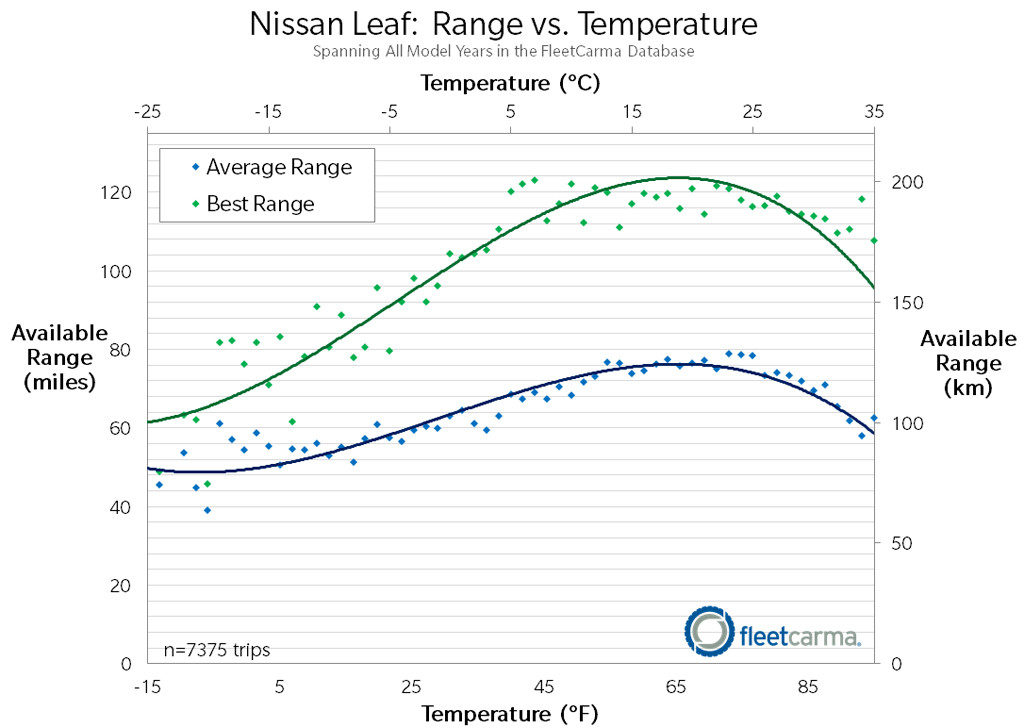
There are public chargers “everywhere”
Another discovery we made after purchasing the car is that there are public chargers “everywhere” in the metro Denver area – there are several hundred of them. You will never be more a few miles away from a public charge point. Although Bill and I are both are considered electric vehicle experts, even we were not aware how large the network of public chargers is. We can imagine that most people would have absolutely no clue, and Nissan is not making an effort to communicate this huge advantage. The built-in navigation contains information about many of them, but you wouldn’t know this before you purchase or test drive the car. You can simply pick a charge point as destination on the touch screen. The car will immediately let you know if you don’t have sufficient range to get there. There are apps such as PlugShare [7] that will help you locate additional charge points, including private people that have made their home or business charge plugs available for other people to use. EV World also list electric charging station as well as other alternative fuel filling stations here.
Most of the public chargers in the Denver area are in the ChargePoint® network [8]. Although most of them are free to use, you will need to sign up and get a RFID card to use it.

Other great details
The Nissan Leaf engineers have definitely paid attention to details. Such a simple thing as the nicely designed holder for the charger plug that you mount on the outside of your garage makes the charging routine really effortless. Just unplug the car and slide the plug (that resembles a gas pump handle) into the holder and it will protect the connectors from snow and rain.
Because the heat in an electric car also is electric, you don’t have to wait for the engine to warm-up before you have cabin heat. The heat is almost immediate, and it is definitely immediate if you use the remote start.
Unexpected side-effects: Electric car = More work-outs!
I have discovered an interesting side-effect with owning an electric car: I go to the gym more often!
One of the worst things with going to the gym during the winter is that you have to sit down on an ice-cold seat with your thin workout pants. The distance to my gym is just too long for walking, which also means that it is too short for the heat to really start working in a conventional car.
With the Nissan Leaf, I just open the app on the phone or tablet and start the heat in the car while it is still plugged in. By the time I have changed to work-out clothes and filled my water bottle, the car is warm! That makes it so much easier to drag myself to the gym. Another motivator is that as soon as you have started the heat in the car, you are committed to work out. If you don’t work out, you would have wasted that electric energy for nothing.
The result: Electric car = More work-outs!
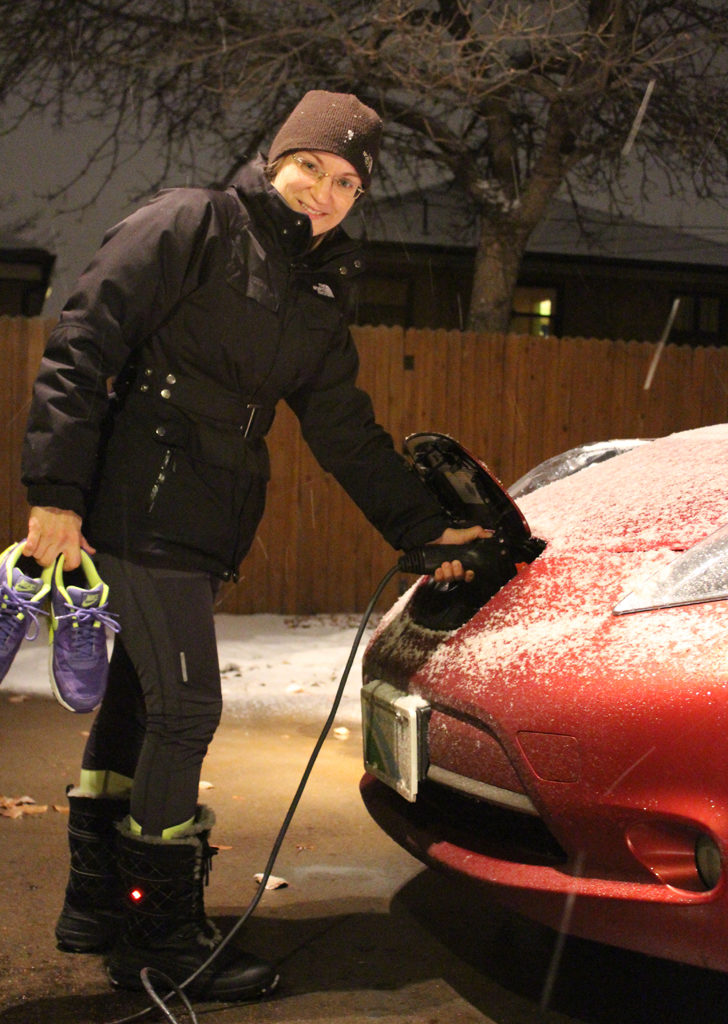
Conclusion – just like a normal car, and sometimes even a bit better
After two years with the Nissan Leaf, we can conclude that it is not much different than owning any modern premium car. It is peppy, comfortable and handles great. You forget that it is anything different, until you jump into an internal combustion car and realize how noisy it is, and how annoying it is to crank it to start. It is really convenient never having to look for a gas station or making an appointment for an oil change, but annoying when you have to make an extra trip to buy windshield washer fluid.
The Nissan Leaf is, of course, not a car for cross-country driving. If that is your intention, you will need to get another car. But since most of us just drive back and forth to work, it is the perfect and just like a normal car. For winter driving, it is even better than a conventional car. You can start the heat remotely without getting a ticket for having a “smoker” on your driveway and it handles great. It is also much cheaper to drive than a conventional car, even with the currently very low fuel prices.
We drive typical routes in a normal matter, and we get about 3.4 miles per kWh in the winter, and 4 miles per kWh in the summer. A kWh costs us about 14 cents, which is very close to the national average. This works out to an average of just 4 cents per mile. A typical 30 mpg car burning $2.50 per gallon gasoline costs about 12 cents per mile, which is three times as much.
Another pleasant surprise is the lack of maintenance. You only have to rotate the tires and buy new tires when they wear out. That’s it. No tune ups. No oil changes. Brakes last a long time because you use regenerative braking most of the time instead of the mechanical brakes. No transmission. No clutch. No fuel filter. No exhaust system or muffler to replace. No oxygen sensor. Nothing. Even the battery is warrantied for 80,000 miles.
What more can you ask for?
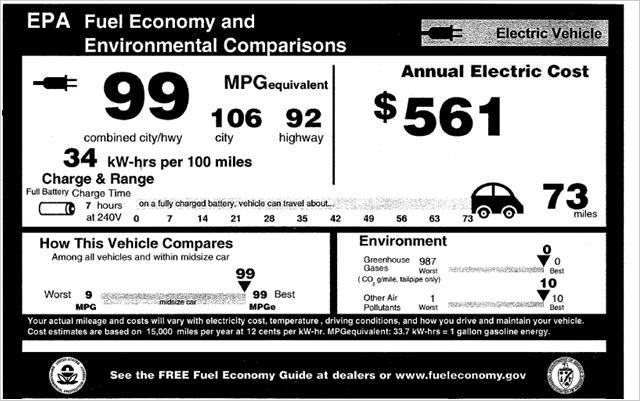
This post was originally published March 2015, and it was updated November 2016.
More interesting articles about the Nissan Leaf:
LEAF battery packs are WAY more reliable than gasoline and diesel engines http://www.treehugger.com/cars/5-years-after-going-sale-europe-leaf-battery-packs-way-more-reliable-gasoline-diesel-engines.html?utm_content=buffer82583&utm_medium=social&utm_source=facebook.com&utm_campaign=buffer
[toggles behavior=”toggle”]
[toggle title=”References”]
References:
[2] http://www.esrl.noaa.gov/psd/boulder/
[3] http://www.nissanusa.com/blog/carwings-app
[4] https://www.cars.com/articles/2011/06/2012-nissan-leaf-battery-warmer-more-details/
[5] http://www.nissan-global.com/EN/TECHNOLOGY/OVERVIEW/heat_pump_cabin_heater.html
[6] http://www.fleetcarma.com/nissan-leaf-chevrolet-volt-cold-weather-range-loss-electric-vehicle/
[8] http://www.chargepoint.com/
[/toggle]
[/toggles]
